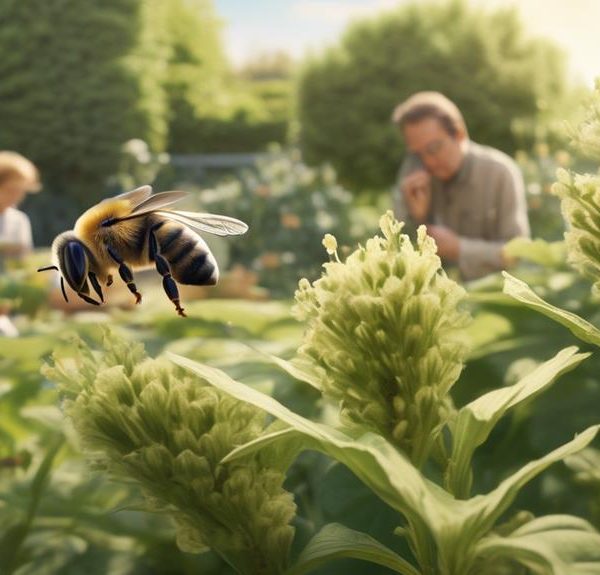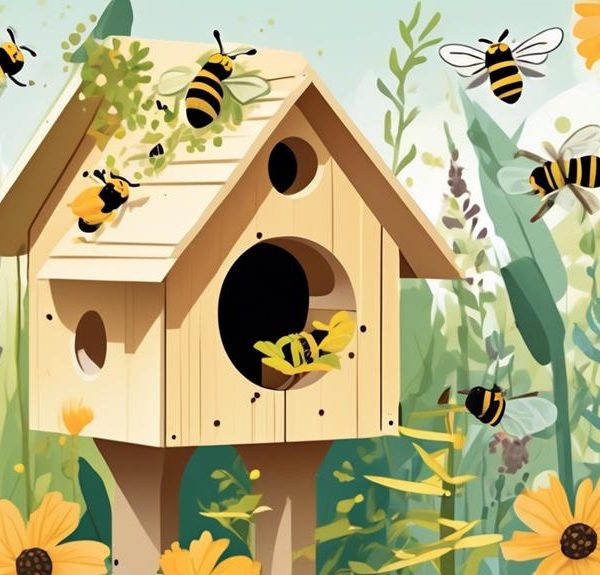Hive into the buzzing world of leafcutter and honey bees, uncovering their unique traits and ecological roles in our ecosystem.

Leafcutter Bee Vs Honey Bee
Navigating the world of bees is akin to exploring a vast, buzzing metropolis, teeming with diverse species each playing their unique roles.
You've likely heard of the industrious honey bee, a pollinator par excellence, revered for its honey production and critical role in agriculture. But, have you met its lesser-known cousin, the leafcutter bee?
While not as famous, the leafcutter bee is equally fascinating and significant in our ecosystem. As we compare and contrast these busy insects, you'll discover intriguing behaviors, unique ecological roles, and varied interactions with human society.
So, why not stick around? You might just find your perceptions on bees are about to be beautifully upturned.
Key Takeaways
- Leafcutter bees are solitary insects that construct individual nests, while honey bees live in large, complex societies with a queen, workers, and drones.
- Leafcutter bees are efficient and selective pollinators, with their hairy bodies collecting pollen while foraging, while honey bees visit a variety of flowers.
- Leafcutter bees are primary pollinators that contribute to maintaining biodiversity, while honey bees are secondary pollinators that aid in agriculture.
- Leafcutter bees have unique nesting behaviors, cutting leaves or petals to create their nests, while honey bees exhibit sophisticated social behaviors, including the use of a 'waggle dance' for communication.
Understanding the Leafcutter Bee
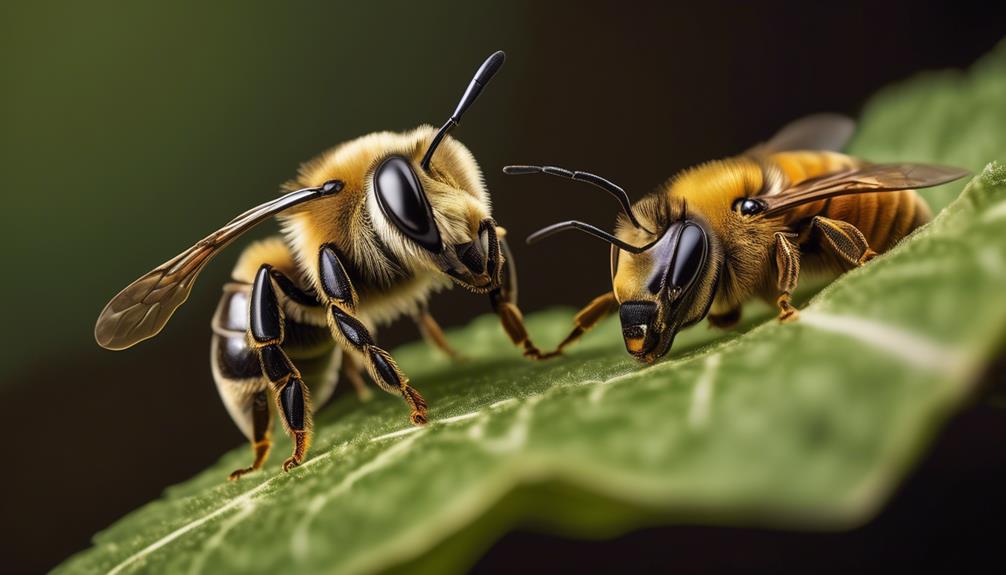
Diving into the world of leafcutter bees, you'll quickly discover these industrious insects are a fascinating species renowned for their unique ability to slice through leaves with incredible precision. This isn't just a random act, but a well-executed strategy they employ to create protective coverings for their young.
Scientifically known as Megachile, leafcutter bees are a solitary species, meaning they don't live in hives like honey bees. Instead, they construct individual nests in rotting wood or in the hollow stems of plants. They're not just crafty builders, but also efficient pollinators. You'll find that their hairy bodies pick up pollen while foraging and effectively cross-pollinate plants, making them crucial for maintaining biodiversity.
Moreover, you're unlikely to be stung by a leafcutter bee unless you handle them aggressively. They're docile creatures who'd rather focus on their nesting duties than engage in a fight.
In the grand scheme of things, leafcutter bees are an integral part of our ecosystem, showcasing the wonders of insect life. Understanding them is the first step towards appreciating their role in our environment.
Getting to Know Honey Bees
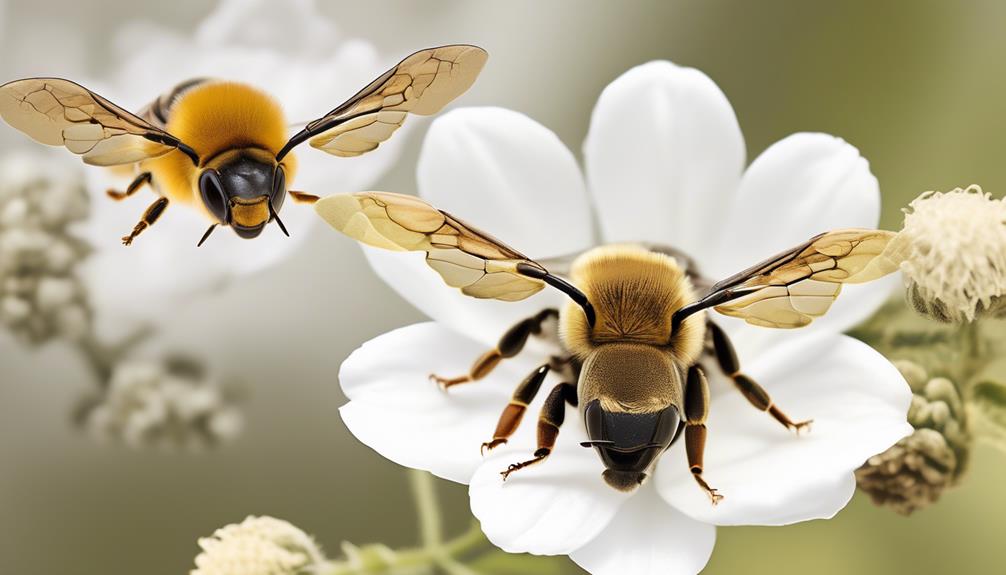
While you've now gained an understanding of the solitary Leafcutter bee, let's shift our attention to the sociable Honey bee, another insect equally crucial for our ecosystem. Unlike Leafcutters, Honey bees live in large, complex societies, with a single queen, numerous workers, and a handful of drones, each with a specific role.
Known scientifically as Apis mellifera, these bees are renowned for their honey production. They forage for nectar, storing it in their honey stomach, then regurgitate and dehydrate it back in the hive to produce honey. This sweet substance not only provides food for the bees but also has significant medicinal properties for humans.
Leafcutter Bee | Honey Bee | |
|---|---|---|
Habitat | Solitary, leaf nests | Social, hive nests |
Diet | Pollen and Nectar | Honey and Pollen |
Role | Pollination | Honey Production |
Lifespan | Short (few weeks) | Longer (few months) |
Honey bees also play a crucial role in pollination, just like Leafcutters. They visit a large variety of plants, transferring pollen as they go, which aids in plant fertilization. Understanding these insects' intricacies helps us appreciate their contribution to our ecosystem.
Comparing Their Unique Behaviors
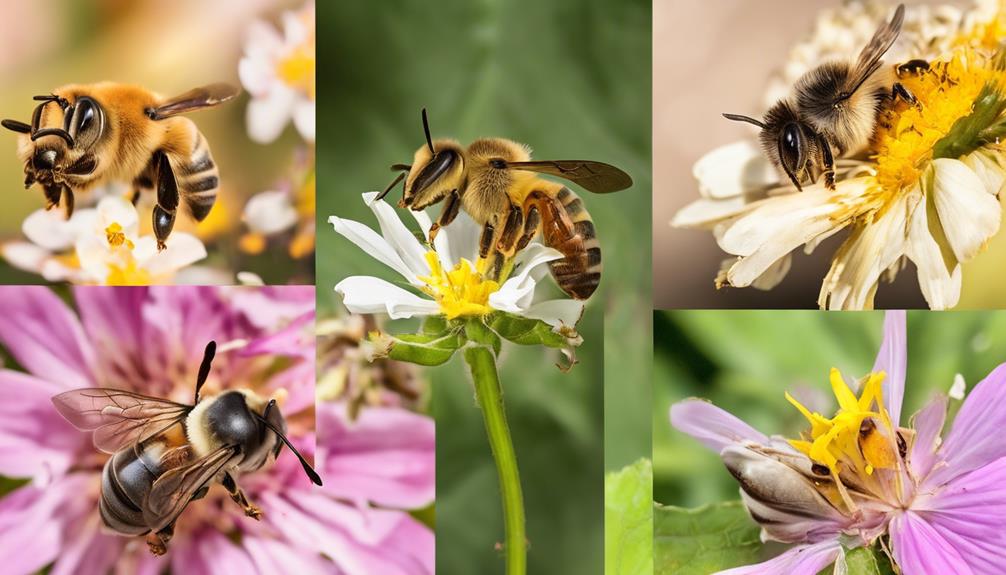
In comparing the unique behaviors of Leafcutter and Honey bees, you'll quickly notice stark differences, reflecting their contrasting lifestyles and societal structures.
The Leafcutter bee, a solitary insect, exhibits independence in its actions. They're known for their characteristic behavior of cutting leaves or petals, which they use to create solitary nests for their offspring.
Contrastingly, Honey bees display sophisticated social behaviors. Their colonies, consisting of a single queen, numerous workers, and a small number of drones, operate in a highly coordinated manner. Each bee has a specific role, from foraging for nectar and pollen, defending the hive, to caring for the larvae.
When it comes to communication, Honey bees have evolved a unique 'waggle dance' to convey the location of food sources to their hive mates. Leafcutters, on the other hand, don't exhibit such complex communication; their solitary nature doesn't require it.
Even their interactions with plants differ. While Honey bees are generalists, visiting a variety of flowers, Leafcutters are more selective, preferring certain plant species over others. These behavioral differences illustrate how each bee species has adapted to their respective ecological niches.
Ecological Role Differences
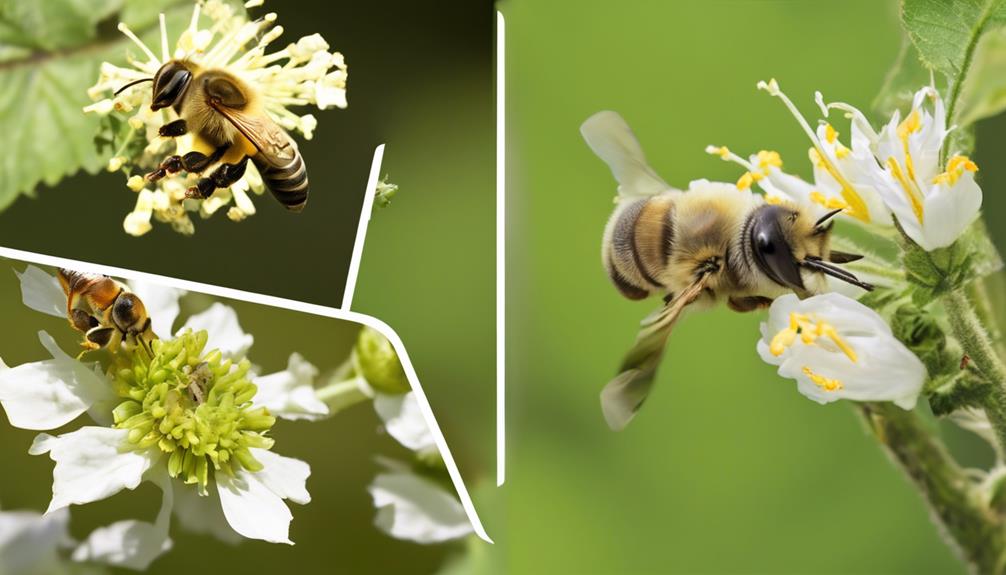
Significant distinctions emerge when you examine the ecological roles that Leafcutter and Honey bees play in their respective environments. Leafcutter bees are solitary creatures and primary pollinators, playing a vital role in maintaining biodiversity. They're widely recognized for their unique nest-building behavior, cutting leaves to line their nests.
On the other hand, Honey bees are social insects living in large colonies, mainly known for honey production. They're secondary pollinators, but their large numbers ensure widespread pollination, benefiting agricultural landscapes.
The table below breaks down these ecological roles:
Leafcutter Bees | Honey Bees |
|---|---|
Primary Pollinators | Secondary Pollinators |
Contribute to Biodiversity | Aid in Agriculture |
Solitary | Social |
Unique Nest-Building | Honey Production |
You see, Leafcutter bees contribute more to biodiversity as they pollinate a range of plants. Honey bees, while not as effective individually, make up for it through their sheer numbers. Their social nature allows them to pollinate on a large scale, benefiting various crops. Thus, both bee types play crucial, yet different, roles in ecology, underlining their individual importance.
Interaction With Human Society

Moving from their ecological roles, let's now explore how Leafcutter and Honey bees interact with human society, impacting our lives in significant yet varied ways.
Leafcutter bees, although not as widely recognized, are crucial to human society mainly because of their superior pollination abilities. They're solitary bees, which means they don't produce honey or beeswax, commodities traditionally associated with bees. However, their meticulous and efficient pollination significantly boosts crop yields, directly contributing to the agricultural economy.
On the other hand, honey bees are recognized for their honey and beeswax production, commodities used in various industries like food, cosmetics, and even medicine. Their social structure allows for large-scale production, making them economically important. Plus, they're also pollinators; however, their pollination efficiency is less than that of leafcutters.
Both species, despite their differences, play important roles in human society. They contribute to biodiversity, agriculture, and various industries. However, they're threatened by factors like pesticides, habitat loss, and climate change.
As a society, it's crucial we invest in conservation efforts to protect these invaluable insects. Understanding their role in our society can help guide these efforts.
Conclusion
In conclusion, you've seen how leafcutter bees and honey bees significantly differ.
From their behaviors to their ecological roles, these species are unique. Leafcutters are solitary, diligent pollinators, while honey bees are renowned honey producers.
They both hold crucial roles in our ecosystems, and our world would look drastically different without them. Understanding these differences not only enriches our knowledge but also underlines the importance of their conservation.

